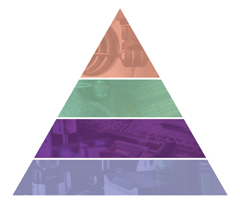Przygotowanie procesu
Zautomatyzowane ustawianie z wykorzystaniem sond pomiarowych może być do 10 razy szybsze niż w przypadku metod manualnych.
Elementy kontroli w warstwie przygotowania procesu piramidy produktywności procesu (Productive Process Pyramid™) ustalają zależności pomiędzy obrabiarką, przedmiotem obrabianym oraz narzędziami zanim rozpocznie się skrawanie. Te zautomatyzowane, prognostyczne elementy kontroli dają pewność, że już pierwsze skrawanie będzie poprawne.
Zadbaj, aby pierwsze skrawania były dokładne

W warstwie przygotowania procesu Piramidy rozpoznaje się takie źródła zmienności, jak położenie przedmiotu, wymiary narzędzi i offsety na obrabiarce, skupiając czynności obróbkowe na aktualnym położeniu przedmiotu w przestrzeni obróbczej maszyny.
Są to prognostyczne elementy kontroli, stosowane tuż przed rozpoczęciem skrawania.
W procesie ustawiania narzędzi następuje ustalenie
- długości od czoła wrzeciona w celu określenia offsetu wysokości oraz sprawdzenia, czy długość odpowiada definiowanej tolerancji,
- średnicy podczas obracania się narzędzia w celu określenia offsetu jego wymiaru.
W procesie ustawiania przedmiotu obrabianego następuje ustalenie
- identyfikacji przedmiotu w celu wybrania właściwego programu sterowania numerycznego (NC),
- położenia elementu bazy wymiarowej w celu ustanowienia układu współrzędnych roboczych (WCS),
- rozmiaru półproduktu/przedmiotu obrabianego w celu określenia stanu naddatku oraz sekwencji skrawania zgrubnego,
- zorientowania przedmiotu obrabianego (względem osi maszyny) w celu określenia obrotu układu współrzędnych.
W procesie ustawiania obrabiarki następuje ustalenie
- zestrojenia osi obrotowej, podzielnicy lub elementów zamocowania, niezbędnych do pozycjonowania i uchwycenia przedmiotu obrabianego,
- pozycja środka obrotu indeksera i/lub punkty odniesienia uchwytów.
Kontrola prognostyczna
Zautomatyzowane ustawianie z wykorzystaniem sond pomiarowych może być do 10 razy szybsze niż w przypadku metod ręcznych, oferując więcej czasu na skrawanie.
Pomiary przy użyciu sond są także przewidywalne – będziesz wiedzieć, ile czasu potrwa ustawianie i będziesz mógł odpowiednio zaplanować czynności.
Procesy ustawiania z zastosowaniem sond pomiarowych zainstalowanych na obrabiarkach, mogą być w pełni sterowane programowo, tak aby wykwalifikowani operatorzy nie byli już potrzebni do wykonywania pomiarów, przeprowadzania obliczeń oraz do wprowadzania zmian offsetów.
Sondy do kontroli przedmiotów obrabianych, układy ustawiania narzędzi oraz oprogramowanie Productivity+™ firmy Renishaw są narzędziami niezbędnymi do szybkiego, automatycznego i powtarzalnego ustawiania operacji skrawania.
Dokumenty
-
 Broszura: Systemy metrologiczne przeznaczone do kontroli procesu produkcyjnego
Broszura: Systemy metrologiczne przeznaczone do kontroli procesu produkcyjnego
Poprawa produktywności dzięki usprawnieniu kontroli procesów produkcyjnych
